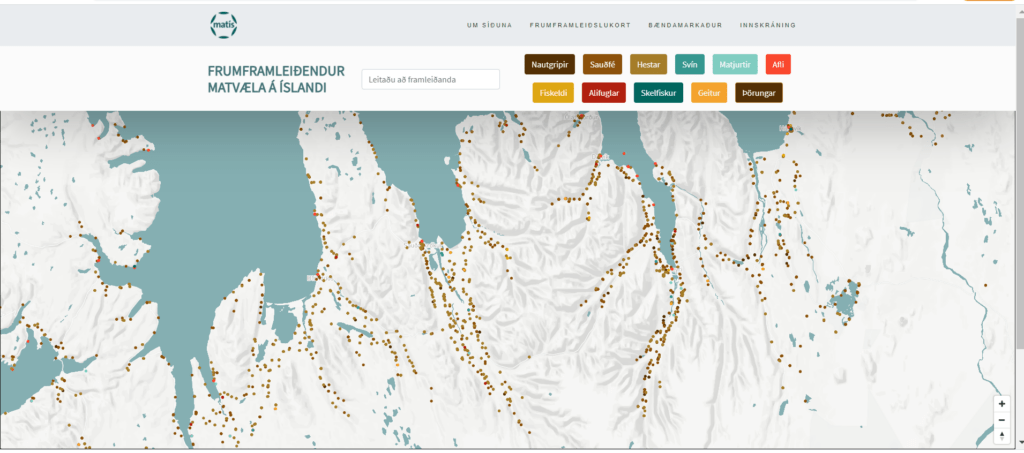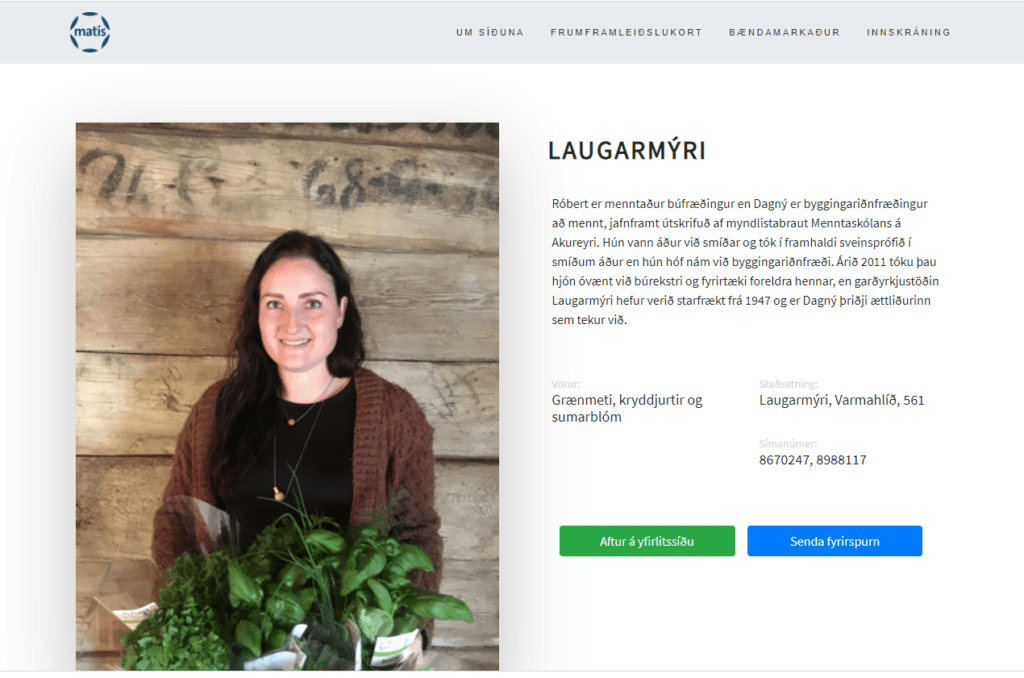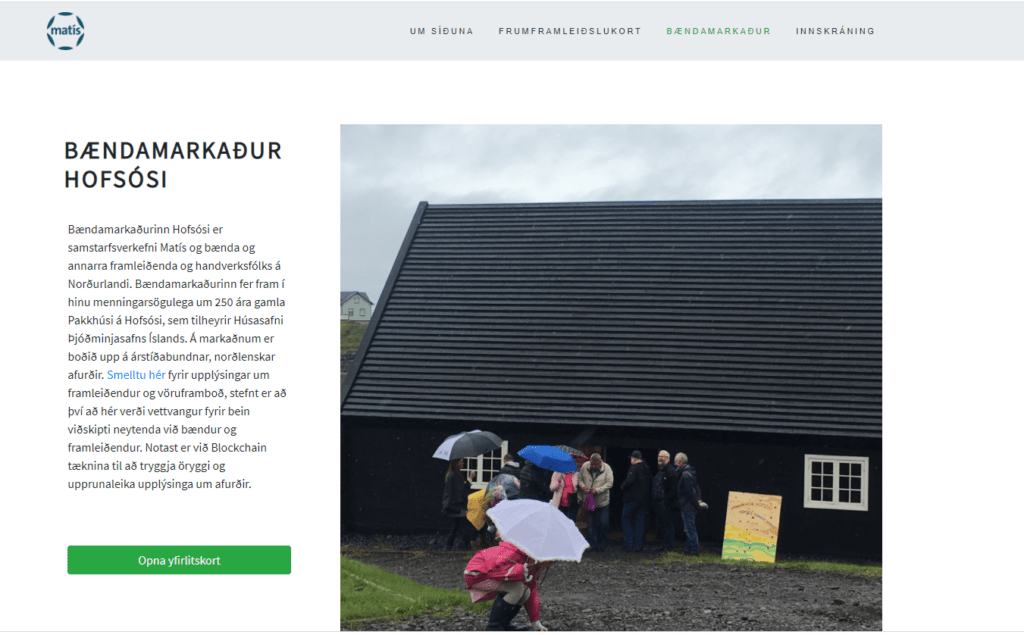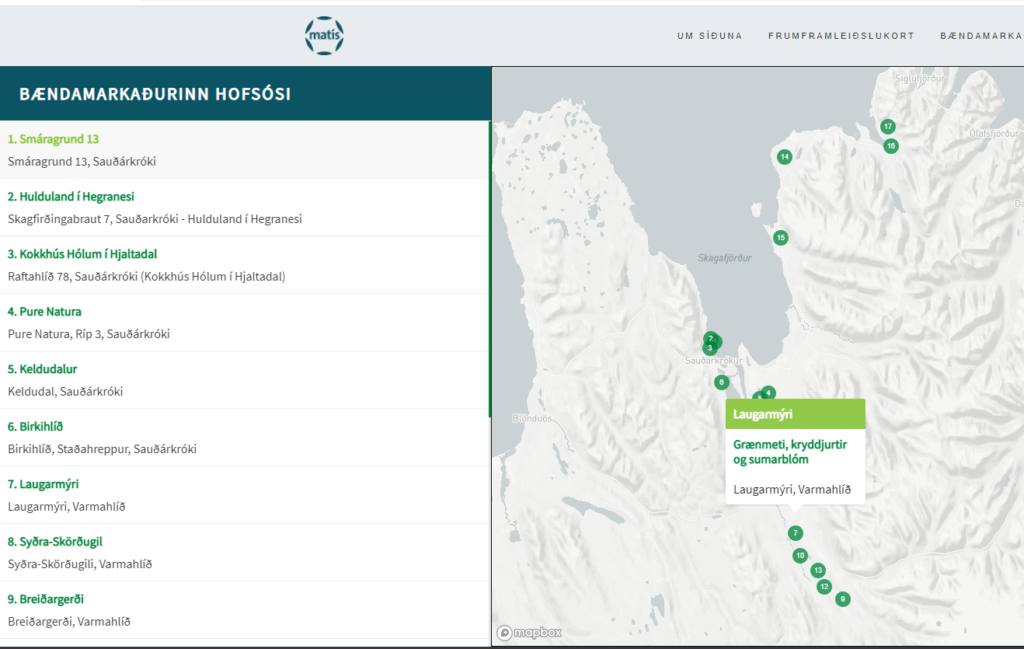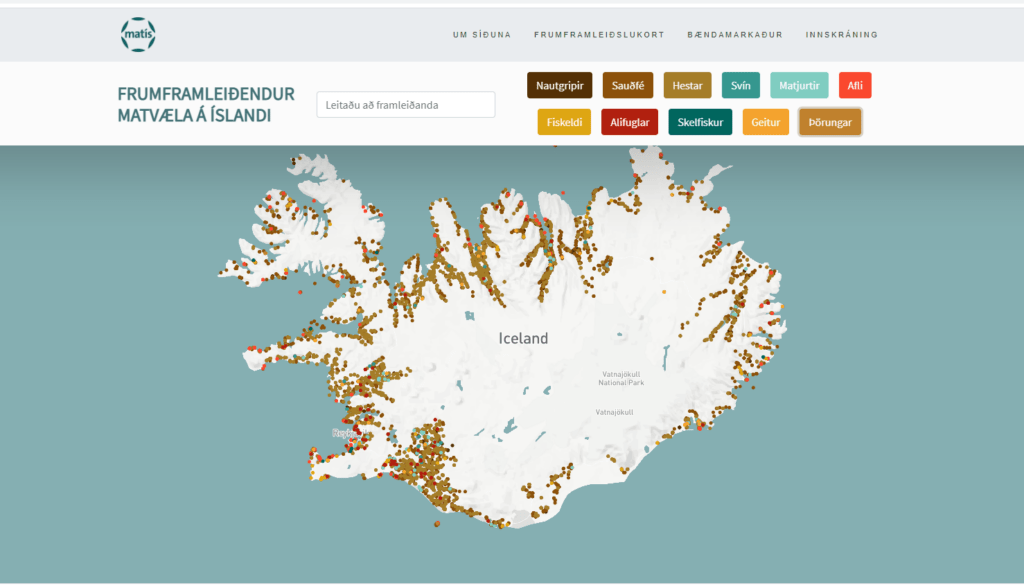The Matarlandslagið project involves the creation of a comprehensive, accessible and sustainable database, website and app, which contains a list of all primary production in Iceland. The project is based on an incomplete prototype that Matís has developed recently and can be found at the URLs www.matarlandslagid.is and www.eaticeland.is
In Iceland's Food Policy until 2030, in line with the United Nations Sustainability Goals until 2030 and the Paris Agreement from 2015, great emphasis is placed on increasing sustainability in all areas of food production from resource to consumption, but the policy states, among other things:
All food value chains are important, from production methods to consumer satisfaction. It is important how food is produced, distributed, bought and consumed, but at the same time that it is safe and that utilization in production and consumption is as good as possible. Sustainability is the basis of a good standard of living for the future (p. 6).
The production of food directly from Iceland's food resources, or primary production where, for example, a farmer farms the land or raises animals or the fisherman catches fish from the sea, is the basis of all Icelandic food and a prerequisite for Iceland's food security. An overview of the primary food production in the country and knowledge of the situation is the basis for informed decisions and purposeful, effective policy-making and steps for progress, but no such comprehensive overview is available today. Such an overview, based on regularly updated information, would make it easier for governments at all levels of government to take effective steps towards greater sustainability and progress. The overview and knowledge of the primary producers themselves can be the key to development, innovation and employment opportunities, through dialogue and collaboration between primary producers and primary production sectors. But such knowledge can also facilitate direct, direct trade between consumers and primary producers, thus promoting sustainable trade and increasing the diversity of supply and innovation.
With the project The food landscape, will create a comprehensive, accessible and sustainable database, website and app, which contains a list of all primary production in Iceland. It is based on an incomplete prototype that Matís has developed recently. year (see www.matarlandslagid.is or www.eaticeland.is ). A map with the locations of all primary producers is the basis and there are several primary production categories, each with its own characteristic color (eg cattle, sheep, horses, pigs, vegetables, aquaculture, poultry, shellfish, goats, algae, catch from the sea…, which can be clicked The original manufacturer's information page may contain all the information he chooses to provide, eg about production products, production methods, product sales, location, telephone numbers, e-mail addresses, website, affiliates to which the primary producer is a member, services that the primary producer offers (such as farm accommodation, on-site trade, zoo, entertainment, horse riding, market and so on), events / farmers market / drift market / festivals / exhibitions in which the producer participates, photos of products and situations, electronic order form for direct online transactions, etc. It is ensured that the information about the primary producers is always correct, as the primary producer has special access to his own information page and updates it in a simple way himself by logging in with a special password that he alone has access to. The primary producers' site provides detailed information with pictures. The aim is that the organizers of events in which primary producers participate around the country can also apply for a special information page within the Food Landscape, which they update themselves by logging in, where detailed information about the event and date is provided. The food landscape will then contain and publish an constantly updated event calendar with information about events / farmers' markets / rekomarkaður / festivals / exhibitions, etc. around the country where all the events recorded by the organizers are displayed. It would also be possible to see the distribution of events across the country over a certain period (for example, events in July are shown on a map as a location point with the date and type of event and when you click on the location point, an information page for the relevant event appears).
The project will be carried out in collaboration with the umbrella organization of various unions and associations of primary producers who process products from the country's resources. The value of such co-operation is unequivocal in terms of knowledge of the direct connection of such associations with the primary producers themselves through member associations and associations, but Matís has extensive and good experience of co-operation with primary producers all over the country, which will be useful in the project.
The food landscape is intended to provide a clear overview with regard to, among other things, sustainable development and development in accordance with the United Nations Global Goals and the Paris Agreement. Matarlandslagið will also be used to gather information and educate about Iceland's food production and food culture heritage and its development. Primary producers, the tourism industry and the restaurant industry will be able to use the Food Landscape to promote the food characteristics of each region and where and how to obtain domestic products that characterize different areas and Iceland as a whole. The products of the project are therefore the following:
- Accessible forum open to all: The website provides access to updated factual information on the supply, accessibility and nature of primary production products in Iceland and the communities that create these products.
- Increased understanding and knowledge of consumers about the primary production of Icelandic food: Perspective and understanding enable consumers to focus their consumption on reducing the negative consumption-related environmental impact and thus take small steps against global warming and promote an environmentally friendly society.
- Tools for the government at all levels to provide a broad overview of the situation: The file and its graphical presentation of the Iceland Map provide the government at all levels with a detailed overview of Icelandic primary production, for informed policy-making, decision-making, innovation and development in line with sustainability and development goals.
- Tools for tourism operators and companies for targeted marketing: A clearer view of the supply of products, services and entertainment, the nature of that supply, its development, history and special characteristics is a tool for tourism operators for targeted marketing and clearer planning.
- Increased collaboration between primary food producers and other sectors: An improved overview of the industry can reveal untapped opportunities for further innovation and encourage co-producers in new areas. In this context, we can mention, for example, the co-production of primary producers with tourism companies, biotechnology companies and various cultural activities, but also other food producers.
- Improved food security and independence in food production: Domestic food production is the basis of food security. A society that has to rely too much on external food production to be able to feed its citizens can experience insecurity in the event of unforeseen circumstances, natural or man-made. This is especially true of island states. Despite people's belief in the inexorability of modern freight transport, the Covid epidemic has demonstrated the importance of shorter regional supply chains in responding to unexpected events that could threaten the country's food security.
With Matarlandslagið, it will be possible to take important, identifiable and effective steps towards sustainability, development and innovation in line with the action plan of Matvælastefna Íslands until the year 2030, but the policy states the future vision on p. 2:
- The reputation of Icelandic food production is good and is characterized by purity where quality and safety are paramount.
- Health, innovation and technology are key elements in Icelandic food production.
- Nature, culture, history and sustainability make Iceland an exciting destination for food lovers.
- Icelandic consumers' access to information is good, they are aware of the environmental impact of production, its quality and nutrition and know their rights as consumers.
- Sustainable consumption and production patterns are ensured in accordance with the United Nations Global Goals.
It is also sufficient to refer to the chapter title of the policy as an indication of the extensive potential of the Food Landscape as a benefit to achieve the goals of the policy, but the titles of the chapters and topics are "Productivity and innovation increase prosperity", "Strong position increases freedom and choice", "Cooperation ensures welfare" Improving the quality of life is for the benefit of all "and" Sustainability is fundamental ".
The Food Landscape will contribute to the preservation of the cultural heritage that is our food culture and is often the basis of the distinctive communities around the country. The development of food culture, employment opportunities and value added in the local area will also be promoted by supporting primary producers who use old methods and produce food in the traditional way, as well as those who develop traditions and process food in new ways and promote innovation. The cultural heritage, culture and characteristics of communities around the country are largely based on the food provided by the area's food resources. The cultural characteristics of communities are the basis on which to base their development, as well as livelihoods, such as in the form of cultural and food tourism and production.
There are countless opportunities for primary producers and settlements around the country for the purposeful and sustainable development of thriving settlements where the emphasis on cultural characteristics and traditions in cooking and the development and implementation of these in each place are in the foreground. The food landscape thus gives Icelandic consumers as well as foreign visitors the opportunity to get to know Icelandic food and its connection to Icelandic culture in a more purposeful way. This could also encourage further development of primary production and bring communities across the country increased profitability and the possibility of sustainable development with a clearer view of the strength of their own community and the special characteristics of the food resources of each region. Farmers and other primary producers can also use the web to see what their colleagues around the country are doing and get ideas and enthusiasm for development, innovation and collaboration.
The result is that communities around the country get a clearer view of "Who we are, what we have to offer and how we do it in a successful and sustainable way for the development of society".
Consumers would also share this vision of what our uniqueness is in each place and what is desirable in each place, and governments at all levels will also share this vision and be able to build on it in policy-making and decision-making on sustainable development, innovation and development. It would be a strengthened and clearer view of how our traditions and culture have created and developed societies around the country.
Foreign parties, including tourists, restaurants, companies, educational and cultural institutions, will also have easier access to information on the characteristics and traditions of Icelandic food, each region and place and food types, in terms of food culture and its development, as well as to increase access to Icelandic assessment and knowledge of him.
Finally, Matarlandslagið will draw attention to the important work that Icelandic primary producers do, which contributes to the sustainability of our society and be an incentive for further progress and action in this direction.
Overall, a powerful tool can be envisaged for the development of primary production around the country, where farmers and other primary producers will be able to take advantage of the opportunities inherent in an active, purposeful and powerful flow of information for targeted production and development.
In order to ensure the sustainability of the Food Landscape, the database and the website, it is important that supervision and maintenance be in the hands of parties responsible for primary producers. It is foreseeable that in the future it will be most effective for the umbrella organization of primary producers' associations to be given that role, even more than one umbrella organization (for example, both the umbrella organization for land and sea products in the future, and each of them in its own field). The management includes minimum actions, which mainly consist of approval of the registration of new primary producers and events applying for the login page, general maintenance and software updates, as well as regular promotion and marketing of the database / website to maintain its functionality and usefulness.


